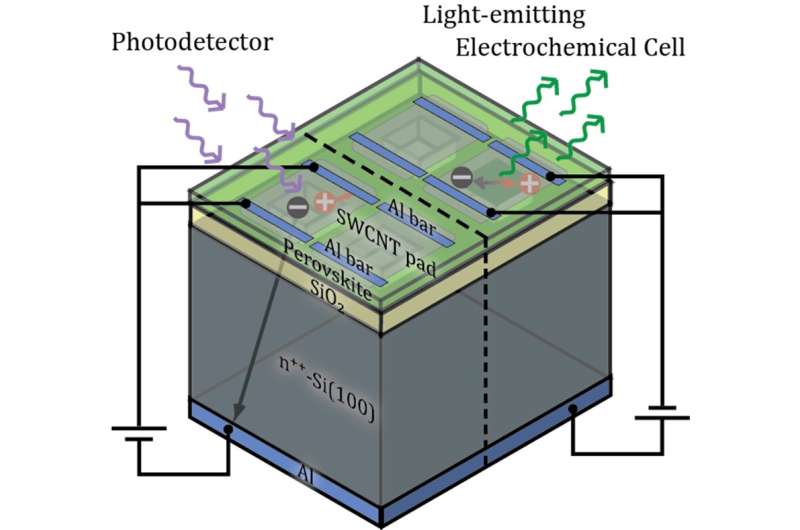This article has been reviewed according to Science X's editorial process and policies. Editors have highlighted the following attributes while ensuring the content's credibility:
fact-checked
proofread
Novel design perovskite electrochemical cell for light-emission and light-detection

Although halide perovskite light-emitting devices exhibit exceptional properties, such as high efficiency, high color purity and broad color gamut, their industrial integration generally suffers from the technological complexity of devices' multilayer structure alongside in-operation-induced heating poor stability.
Halide perovskite light-emitting electrochemical cells are a novel type of perovskite optoelectronic device that differs from the perovskite light-emitting diodes by a simple monolayered architecture. The perovskite light-emitting electrochemical cell consists of a silicon substrate, multifunctional single composite perovskite layer (a mixture of halide perovskite microcrystals, polymer support matrix, and added mobile ions), and transparent single-walled carbon nanotube film top contact.
Due to silicon's good thermal conductivity, the device endures 40% lower thermal heating during operation compared to conventional ITO/glass substrate. Moreover, when a positive bias is applied to the device it yields a luminance of more than 7,000 cd/m2 at 523 nm (green color). When a negative bias is applied to the device it operates as a photodetector with a sensitivity up to 0.75 A/W (for wavelength in blue or UV regions), specific detectivity of 8.56∙1011 Jones, and linear dynamic range of 48 dB. The technological potential of such a device is proven by the demonstration of a 24-pixel indicator display as well as successful device miniaturization by the creation of electroluminescent images with the smallest features less than 50 μm.
The perovskite light-emitting electrochemical cells are a viable alternative to the conventional perovskite material device research light-emitting diodes. Not only do perovskite light-emitting electrochemical cells have a much simpler architecture and design with one single functional layer replacing multiple active, charge-separation and transport layers of perovskite light-emitting diodes, but also perovskite light-emitting electrochemical cells can possess all the extraordinary properties of LEDs, such as high efficiency, high color purity and broad color gamut.
The reason that perovskite light-emitting electrochemical cells are capable of this is completely different from the LEDs operation principle: when electrical bias is applied to the device, mobile positive and negative ions inside the perovskite layer migrate toward corresponding electrodes dynamically forming a p-i-n structure inside the perovskite layer, which allows effective electron-hole recombination with photon emission. Comprehensive research on various back-ups to conventional LED technology is a valuable source of diversifying the pool of industrial opportunities.
The reported device demonstrates exceptional light-emitting and light-detecting ("dual-functionality") characteristics alongside an enhanced in-operation heating durability. This is possible due to the utilization of silicon substrate in the perovskite light-emitting electrochemical cells' design. Silicon material is one of the stepping stones of the CMOS technology—complementary metal–oxide–semiconductor technology—technology used in manufacturing of all semiconductor chips, displays, etc. Integration of such an emerging material like perovskite material with silicon brings the R&D community one step closer to obtaining an industrial perovskite light-emitting electrochemical cell.
The broader benefit of the reported device design is its ITO-free transparent electrode based on single-walled carbon nanotubes. ITO—Indium-Tin Oxide—is a transparent conductive material widely used in perovskite photovoltaics and optoelectronics. Indium is a depleting element and, thus, the replacement of ITO by other materials based on earth-abundant elements would overcome the indium deficiency in the industry.
The research is published in the journal Opto-Electronic Advances.
More information: Maria Baeva et al, ITO-free silicon-integrated perovskite electrochemical cell for light-emission and light-detection, Opto-Electronic Advances (2023). DOI: 10.29026/oea.2023.220154
Provided by Compuscript Ltd





















